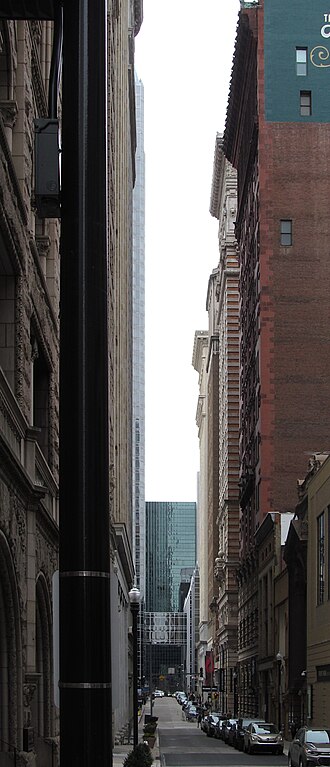
The titanic columns of the Mellon Institute reflected in the Software Engineering Institute.




In his earlier career, Frederick Osterling carved out a niche for himself providing Richardsonian Romanesque buildings for people who couldn’t get Richardson (because Richardson was dead). The Allegheny County Courthouse created a mania for the style in Pittsburgh, and Osterling seems to have had all the work he could handle. In this building from 1892, we see the hallmarks of Osterling’s own variation on the style. He was more florid than Richardson, but he was always aware of the overall composition, never allowing the numerous individual details to break up the carefully orchestrated rhythm of the façade.
Below, we see the Times Building in context, with One Oxford Centre looming in the middle distance.


A proud eagle perches on a keystone, reminding us that this tower on Fourth Avenue was built for the Keystone Bank, though it now houses the Pittsburgh Technology Center. The tower is in a somewhat mutilated state, but many of its decorations are still intact.

“Make no little plans,” said Daniel Burnham; “they have no magic to stir men’s blood and probably themselves will not be realized.” The Chicago Tribune tells us the interesting story of the long search for the original source of that quotation, and the determination that it was in fact what Burnham said. It is probably the second-most-famous quotation from an architect in history: only Louis Sullivan’s “Form follows function” has been heard more often.
Outside Chicago, Pittsburgh was where the great Burnham was most prolific. Many of our most famous buildings—the Oliver Building, Penn Station, the Frick Building, and a good number of others—are by Burnham. Most of them are colossal. But the old Union Trust Company building—now the Engineers’ Society of Western Pennsylvania—was his first work here, and it is on a small scale. Small, but rich and perfect in its way. The front is a traditional Doric temple; the treatment of the top storey behind the pediment seems to enclose the temple in its own perfect world, insulated from the ugly realities of Fourth Avenue commercialism around it. It was built in 1898, and it can be seen as an answer and a rebuke to the tasteless extravagance of Isaac Hobbs’ 1870 Dollar Bank building across the street.

Some of the earliest skyscrapers sprouted on Fourth Avenue, which is an absurdly narrow street for towers like these. Since Pittsburgh never developed a setback rule like Chicago or New York, the towers go straight up, which accents the narrowness of the street even more.

A wood-frame country church whose most identifiable feature is its big square belfry. Artificial siding has eaten up some of the trim and made the walls a little monotonous, but the shapes of the various masses still make an interesting composition.




Two universities in Pittsburgh have signature Gothic skyscrapers. Everybody knows the Cathedral of Learning at Pitt, but Lawrence Hall at Point Park University is also Gothic and also a skyscraper. By a strange coincidence that probably no one else in history has noticed (this is how dedicated old Pa Pitt is to you, his readers), it is within a foot or two of being precisely half the height of the Cathedral of Learning. (Cathedral of Learning: 535.01 feet; Lawrence Hall: 265.72 feet. Source: Emporis.com.)
It was not always Lawrence Hall, of course. It was built as the Keystone Athletic Club in 1927; the architect was Benno Janssen, who also designed the Pittsburgh Athletic Club, the Twentieth Century Club, and the Masonic Temple, all in Oakland, and a remarkable number of other prominent buildings in the city. The Depression was hard on clubs; the Keystone Athletic Club (doubtless saddled with debt from building a skyscraper clubhouse) collapsed in 1934, and after that the building was a hotel until Point Park College picked it up in the 1960s. It was renamed for the Renaissance mayor David Lawrence, and now it anchors the ever-spreading downtown campus of the university.